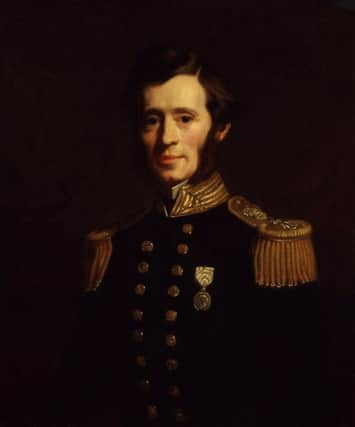Roamer: Ireland's polar heroes whose stories are lost in the frozen mists of time


The exhibition, running till the end of August, vividly recounts the historic treks by the victorious Norwegians, led by Roald Amundsen, and the defeated British team led by Captain Robert Falcon Scott.
They faced horrendous, sub-zero weather conditions, hazardous terrain and relentless blizzards in the race to be first to the South Pole.
Advertisement
Hide AdAdvertisement
Hide AdI mentioned here in passing that Captain Lawrence ‘Titus’ Oates, who uttered the historic ten-word farewell “I am just going outside and may be some time”, was a junior officer in the 6th Inniskilling Dragoons.
News Letter readers have wasted no time highlighting other early polar explorers from Ireland, or with significant local connections!
Some have been mentioned here before, like Antarctic explorer and colleague of Scott - Ernest Henry Shackleton from County Kildare, and Banbridge’s Francis Crozier, who disappeared in 1845 on Sir John Franklin’s search for a North West Passage.
A lesser-recounted Irish link with Antarctica was courageous Kerry-man Tom Crean, a key member of the last team that returned to base camp while Captain Scott thrust on to the South Pole.
Advertisement
Hide AdAdvertisement
Hide AdCaptain Henry Kellet from County Tipperary took part in two Arctic expeditions between 1848 and 1854.
Captain Robert John McClure, born in Wexford, took part in three Arctic expeditions and eventually travelled from the Pacific to the Arctic Ocean between 1850 and 1853.
Dundalk-born naval officer, Francis Leopold McClintock, achieved enormous fame, yet curiously, his Arctic adventures aren’t often told in the land where he was born and brought up!
A News Letter reader e-mailed Roamer a short and intriguing introduction - “Vice Admiral Sir Leopold McClintock, of Redhall House, Ballycarry, discovered the fate of the Franklin Expedition in the 19th century. A channel in the Arctic is named in honour of him.”
Advertisement
Hide AdAdvertisement
Hide AdIt was the son of the explorer, also a much honoured and greatly acclaimed Royal Navy legend - Vice Admiral JWL McClintock - who bought Redhall House in 1927.
His father, polar explorer Francis Leopold McClintock, was born on 8 July 1819 at Seatown Terrace in Dundalk, one of 14 children of the town’s collector of customs, who had formerly been an officer in the 3rd Dragoon Guards.
As a child Francis Leopold had little formal education and entered the Royal Navy in 1831, just before his 12th birthday.
He rose gradually through the ranks and in 1848 he volunteered to take part in an expedition to search for the missing Franklin expedition.
Advertisement
Hide AdAdvertisement
Hide AdSir John Franklin, one of the 19th century’s best known explorers, went on his fourth Arctic expedition hoping to discover the North West Passage with Banbridge’s Captain Crozier in 1845.
They, nor any of their 130 crewmen and fellow explorers, were ever seen again.
During the next 20 years dozens of land and sea expeditions went in search of Franklin and his missing men.
Vice Admiral Sir Leopold McClintock’s first search in 1848 was unsuccessful, and it was probably the only one where there was any hope of finding survivors from the Franklin expedition.
Advertisement
Hide AdAdvertisement
Hide AdTwo more journeys to the Arctic in 1850 and 1852 also proved fruitless, and McClintock became increasingly frustrated as his search parties scoured the coasts of Melville Island, Prince of Wales Land and Beechey Island, though they found the graves of three of Franklin’s crew, and some of their equipment.
In 1854 Franklin’s wife contacted McClintock in Dublin. He helped her to buy a ship, the tiny 177-ton Fox, and in April 1857 she offered him command of another expedition to discover the fate of her husband.
McClintock assembled a small crew, including Dr David Walker from Belfast who was his ship’s surgeon, naturalist and photographer.
After being locked in the ice for almost 12 months off Greenland, and following several hazardous overland treks, in 1858 McClintock’s party found debris, some frozen bodies and notes written by members of the Franklin expedition.
Advertisement
Hide AdAdvertisement
Hide AdOne faded document dated April 1848 told of the rapid deterioration Franklin’s ships, and of the failing health of his men.
The note bore tragic news - “Sir John Franklin died on the 11th June 1847 and the total loss by deaths in the expedition has been to date nine officers and 15 men.”
Amongst the dead was Banbridge’s Captain Crozier.
Today McClintock is hardly remembered at all outside a small community of polar historians.
While his greatest achievement was bound up with Franklin’s fate, during the course of four Arctic expeditions he surveyed and charted huge areas of unknown Arctic coastline, including a navigable North West Passage.
Advertisement
Hide AdAdvertisement
Hide AdHe amassed a vast collection of zoological and fossil specimens, many of them completely new to science.
He developed an innovative system for sledge travelling using support teams and a series of depots.
He even used kites and sails to assist the sledge teams!
He was a greatly acknowledged expert on polar travel, and became known as the father of modern sledging techniques, preferring ‘man-haulage’ rather than sledge dogs.
He died in London on 17 November 1907 and was buried in Kensington cemetery.
Full details of Race to the End of the Earth are at www.titanicbelfast.com